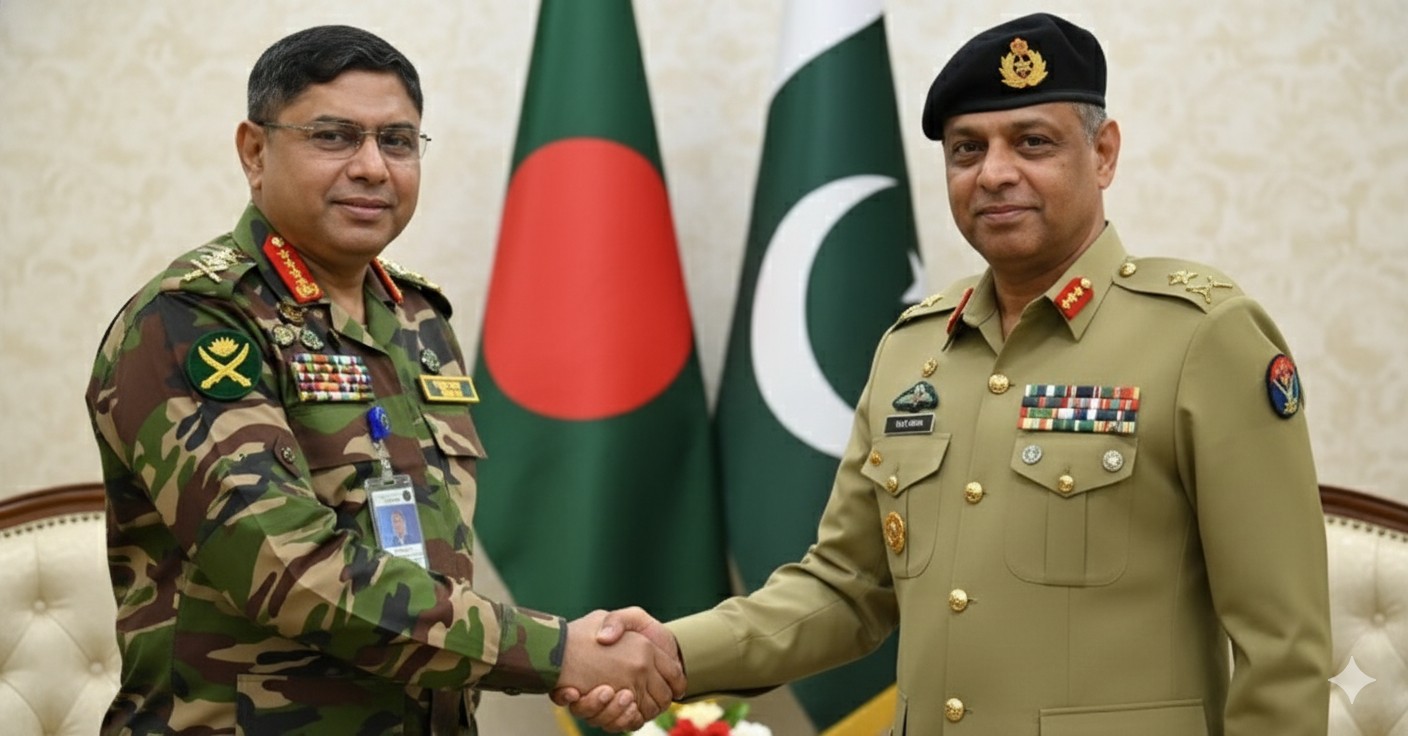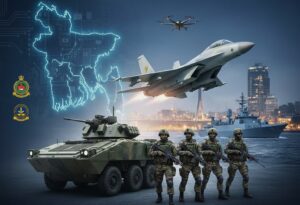Analysing Immediate, Mid-Term and Long-Term Opportunities
Bangladesh’s defence transformation under the Forces Goal 2030 modernisation blueprint continues to reshape the country’s military posture. Over the past decade, Dhaka has methodically enhanced the technological and organisational depth of its armed forces while investing in domestic industrial capacity. The objective is not only to modernise the Bangladesh Armed Forces (BAF) but also to progressively localise sustainment and production across key sectors.
While Bangladesh’s defence partnerships are already diversified—spanning China, Türkiye, South Korea, the United Kingdom, and Italy—Pakistan represents a relatively underexplored yet potentially pragmatic partner. Both countries share complementary experiences: Pakistan has long operated a self-sustaining defence industry built on a diverse platform base, while Bangladesh has prioritised quality, precision manufacturing and cost-efficiency within specific domains.
A structured, purpose-driven Bangladesh defence industry cooperation with Pakistan could help Dhaka address immediate operational needs, reinforce medium-term capability ambitions, and lay the groundwork for technological self-reliance over the long term.
Evolving Context of Bangladesh’s Defence Industry
Bangladesh’s defence industry today is considerably more sophisticated than it was a decade ago. The Bangladesh Ordnance Factories (BOF)—modernised through technical inputs from the Czech Republic’s Česká Zbrojovka and Turkish Mechanical and Chemical Industry Corporation (MKE)—now produces NATO-standard 5.56mm rifles, 7.62mm machine guns, and high-precision ammunition. Annual small arms output is estimated at over 25,000 units, supported by expanding ammunition plants in Gazipur.
The country’s Khulna Shipyard (KSY), Dockyard and Engineering Works (DEW), and Bangladesh Navy Dockyard (BND) have collectively delivered more than 40 vessels since 2010, including fast attack craft (FAC), offshore patrol vessels (OPV), and logistic support vessels—all designed and built domestically.
Pakistan, by contrast, fields a broad-based defence-industrial complex encompassing the Pakistan Ordnance Factories (POF), Heavy Industries Taxila (HIT), Pakistan Aeronautical Complex (PAC) Kamra, and Karachi Shipyard & Engineering Works (KSEW). Together, these organisations employ over 35,000 personnel and have produced notable platforms such as the JF-17 Thunder, Al-Khalid tank, Azmat-class fast attack craft, and Babur cruise missile.
For Bangladesh, Pakistan’s experience in scaling, integrating and sustaining multi-origin equipment offers valuable lessons and practical partnership opportunities.
Immediate Priorities (1–3 Years)
J-10C MRO and Sustained Air Combat Readiness
Bangladesh’s air combat modernisation is advancing rapidly, with the Chinese-origin J-10C multirole fighter representing the next generation of high-performance assets for the Bangladesh Air Force. The J-10C’s WS-10B engine, active electronically scanned array (AESA) radar, and advanced fly-by-wire controls introduce maintenance complexities that require an indigenous sustainment framework.
The Pakistan Aeronautical Complex (PAC) Kamra, which maintains over 200 fighter aircraft annually, including JF-17s, Mirage III/Vs, and K-8 trainers, provides a proven template. A technical partnership between PAC and BAF’s Maintenance and Overhaul Wing could yield:
- A joint MRO training and certification programme for BAF engineers and technicians focused on avionics calibration and life-cycle management.
- Transfer of expertise in engine diagnostics, radar testing, and airframe corrosion control, particularly relevant for Bangladesh’s coastal environment.
- Shared access to PAC’s component repair facilities, enabling BAF to cut downtime by up to 25–30%.
Establishing such an arrangement would directly enhance sortie generation rates and operational readiness.
Cost-Effective Munitions and Ammunition Logistics
Bangladesh’s training-intensive posture—particularly in the Army and Air Force—has driven an exponential increase in ammunition demand. While BOF produces high-quality small arms ammunition, heavy-calibre and air-delivered munitions remain expensive imports.
Pakistan’s POF produces more than 300 types of munitions at relatively low cost per unit due to long-established production lines. A cooperative framework could focus on:
- Adopting cost-efficient casing fabrication and propellant production methods suitable for tropical humidity.
- Joint development of a modular production line at BOF for artillery and mortar shells using POF’s mass-manufacturing design.
- Establishing a shared raw materials procurement consortium to leverage scale economies for brass, nitrates, and composite casings.
Such cooperation could reduce overall ammunition costs for Bangladesh by 15–20%, freeing funds for other modernisation priorities.
Combat Upskilling for Pilots and Command Personnel
To maximise its modern platforms, the Bangladesh Armed Forces require advanced combat training aligned with current operational realities. Pakistan’s military training institutions—such as the Combat Commanders’ School (CCS) at Sargodha and the National Defence University (NDU) Islamabad—offer sophisticated air and joint operations curricula based on real combat experience.
Bangladeshi officers and pilots could benefit from:
- Advanced Air Combat Training (AACT) exchanges emphasising BVR engagement, strike coordination, and SEAD (Suppression of Enemy Air Defence).
- Joint Command and Staff programmes focused on air-ground integration and multi-domain mission planning.
- Ground crew exchange programmes for rapid sortie turnaround, armament safety, and field-level maintenance.
Such human capital development would yield immediate operational dividends for Dhaka’s evolving air doctrine.
Mid-Term Objectives (4–8 Years)
Joint Production of Medium-Cost Munitions
Once basic logistics and ammunition costs are stabilised, Bangladesh can move towards co-production. Pakistan’s experience with precision-guided artillery shells and air-to-ground munitions under Chinese and Turkish collaboration could inform Bangladesh’s efforts to establish a mid-tier guided weapons segment.
Potential projects include:
- Co-production of 122mm and 155mm artillery shells with precision fuse options.
- Joint R&D on laser- or GPS-guided retrofit kits for aerial bombs.
- Transfer of safety and testing protocols for explosive handling and storage.
For Bangladesh, this would build industrial capacity while reducing import dependency on key munitions.
Naval Collaboration and Systems Integration
Bangladesh’s naval shipbuilding record is already strong: since 2010, it has launched more than 20 fast attack craft and missile-capable patrol vessels, many designed domestically by Khulna Shipyard and DEW. Pakistan’s KSEW, which constructed the Azmat-class and Yarmouk-class ships, could support Bangladesh in combat systems integration, particularly missile and EW suites.
Collaboration could include:
- Integration of anti-ship missile systems compatible with Bangladeshi FAC hulls.
- Exchange on combat management systems (CMS) development and crew training.
- Joint R&D on hull vibration control and stealth shaping techniques for radar signature reduction.
This synergy would allow Bangladesh to maintain design sovereignty while absorbing valuable systems-integration knowledge.
Development of UAV and ISR Components
Both nations are developing indigenous unmanned aerial systems (UAS) for surveillance and strike applications. Pakistan’s Burraq UAV and newer Shahpar-II provide a proven base for cooperation.
A Bangladesh–Pakistan partnership could focus on:
- Co-development of medium-altitude long-endurance (MALE) UAVs optimised for maritime patrol and counter-insurgency roles.
- Local assembly of electro-optical payloads and encrypted datalinks.
- Creation of a joint UAS maintenance and testing facility under BAF’s Directorate of Air Intelligence.
Such ventures would establish Bangladesh as a self-sufficient operator and potential exporter of tactical UAVs within the UN peacekeeping community.
Long-Term Prospects (9–15 Years)
Medium- and Long-Range Missile Technology
Over the longer term, selective cooperation in missile systems could provide Bangladesh with indigenous capabilities in precision strike and coastal defence. Pakistan’s missile development ecosystem—rooted in the National Defence Complex (NDC)—offers potential transfer opportunities in propulsion and guidance.
Long-term collaboration might enable Bangladesh to:
- Develop coastal anti-ship missile batteries with 150–200 km range.
- Integrate standoff weapons onto its future fighter fleet.
- Build domestic expertise in solid-propellant production and inertial navigation systems.
Such systems would extend Bangladesh’s deterrence envelope across the Bay of Bengal while maintaining full adherence to non-proliferation regimes.
Combat Electronics and C4ISR Integration
As warfare becomes increasingly network-centric, Bangladesh’s Armed Forces will require advanced command, control, communications, computers, intelligence, surveillance and reconnaissance (C4ISR) capabilities.
Pakistan’s Advanced Engineering Research Organisation (AERO) and National Radio and Telecommunication Corporation (NRTC) already manufacture radar warning receivers, communication jammers, and encrypted radios. Collaborating with these entities could allow Bangladesh to:
- Develop home-grown tactical communication systems for Army and Navy networks.
- Design indigenous electronic warfare (EW) and signals intelligence (SIGINT) suites.
- Create a national battlefield data network integrating air, land and sea sensors.
Such cooperation would future-proof Bangladesh’s digital warfare capability and reduce dependency on foreign suppliers for secure systems.
Aerospace Subassembly and Avionics Manufacturing
By the 2030s, Bangladesh could feasibly participate in regional aerospace component manufacturing through its industrial parks near Gazipur and Tongi. A partnership with PAC Kamra could lead to:
- Production of avionics housings, wiring harnesses, and electronic racks for the JF-17 and J-10C series.
- Establishment of a Bangladesh Aerospace Assembly Centre (BAAC) for subassemblies and structural components.
- Integration of engineering graduates from MIST and BUP into advanced aeronautical R&D.
This would mark Bangladesh’s entry into the regional aerospace value chain and elevate its industrial reputation across South Asia.
Assessment
A pragmatic assessment of potential Bangladesh defence industry cooperation with Pakistan suggests significant opportunity—provided engagement remains guided by strategic discipline and economic logic rather than sentiment.
Operationally, Pakistan’s experience in fighter MRO, munitions production, and integrated training can fill immediate gaps in Bangladesh’s transition towards a modern, high-tempo force. These are areas where cooperation would yield rapid, measurable improvements in sortie rates, ammunition logistics, and combat proficiency.
Industrially, mid-term collaboration in guided munitions, UAVs, and naval systems integration aligns with Bangladesh’s trajectory under Forces Goal 2030. Pakistan’s low-cost production model can help scale these initiatives efficiently, while Bangladesh’s precision manufacturing standards can add quality assurance.
Technologically, long-term cooperation in missiles, C4ISR, and avionics presents high-value opportunities but also requires strong intellectual property safeguards and adherence to export-control regimes. Bangladesh must retain strategic autonomy and avoid overreliance on any single industrial partner.
Diplomatically, engagement with Pakistan must be balanced within Bangladesh’s broader defence ecosystem. Dhaka’s relationships with China, Türkiye, and Western suppliers remain essential for diversified technology inflows. Cooperation with Islamabad should thus remain project-based, outcome-oriented, and insulated from regional political undercurrents.
In sum, cooperation with Pakistan can act as a force multiplier—accelerating capability development, reducing costs, and enhancing human capital—if managed through transparent frameworks and well-defined objectives. For Bangladesh, the guiding principle should remain clear: partnerships that reinforce self-reliance, sustain readiness, and advance the national defence-industrial base in line with the strategic imperatives of Forces Goal 2030.

Amit Bhattacharya is a leading defence procurement expert with deep expertise in modern weapon systems and military hardware acquisition. Over more than a decade, he has collaborated with top defence contractors and strategic research institutions, delivering incisive analysis on procurement frameworks, capability development, and technology integration for armed forces worldwide. Amit bridges the gap between operational requirements and industrial capacity, providing authoritative evaluations of modernisation programmes, defence budgets, and acquisition reforms in both established and emerging defence markets. He leads the Defence Procurement and Defence Industry sections at BDMilitary, shaping strategic discourse on defence innovation. Amit earned his Master of Policy and Governance (MPAG) from the University of Canterbury, New Zealand, complementing his practical expertise with advanced policy and governance insight.



